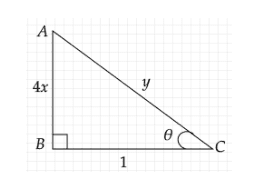Question
Question: How do you simplify \[\sec (\arctan (4x))\]?...
How do you simplify sec(arctan(4x))?
Solution
We will consider the inner function as an angle. Then we will eliminate the function arctan from the resulting expression. Next, we will draw a right triangle based on the expression. Finally, we will find sec of the angle we have considered.
Formula used:
tan(arctan(x))=x
Complete step by step solution:
We are required to simplify the expression sec(arctan(4x)).
Let us begin by denoting the innermost function, which is arctan(4x) as an angle θ. We get
θ=arctan(4x) ………(1)
Let us try to eliminate the function arctan from equation (1) by taking tan on both sides of equation (1). This gives us
tanθ=tan(arctan(4x)) ………..(2)
We will use the property tan(arctan(x))=x on the RHS of equation (2) to get the following expression:
tanθ=4x ………(3)
Let us consider a right triangle ABC with right-angle ∠B as in the figure. Let us take θ as the angle between the sides AC and BC.

Now, from equation (3), we can write
tanθ=14x
We know that in a right-triangle ABC,
tanθ=adj.sideopp.side. Compared with the above equation, we can take the opposite side of the right-triangle as 4x units and the adjacent side as 1 unit.
Now, we have to find the hypotenuse of the right triangle with sides 4x units and 1 units.
By Pythagoras theorem, we have AC2=AB2+BC2. Substituting AC=y,AB=4x and BC=1, we get
y2=(4x)2+12
Taking square root on both sides of the above expression, we get
y=16x2+1 ……..(4)
We are supposed to find the value of sec(arctan(4x)), which from equation (1) is the same as secθ.
We know that secθ=adj.sidehypotenuse. So, from triangle ABC and equation (4), we get
secθ=116x2+1=16x2+1
Note:
The functions tan and arctan are inverse functions. We have used the property tan(arctan(x))=x to eliminate the function arctan, since we cannot use that function in a right-angled triangle. Similarly, we have properties sin(arcsin(x))=x and cos(arccos(x))=x.
